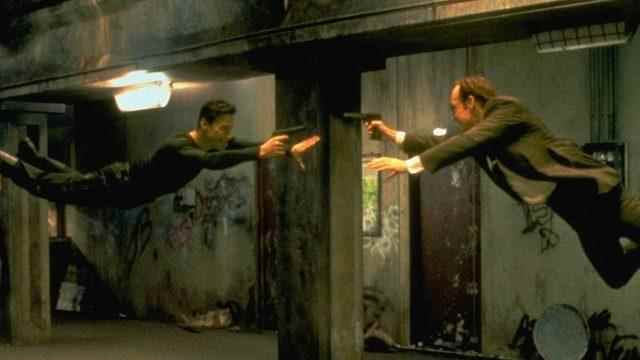Matrix Resurrections, the fourth movie in the Matrix series, will be screened in Turkey on Friday. So, which sci-fi series, which left its mark on a period, left a legacy about the real world prophecies?
“I don’t know what will happen in the future…I came here to tell you how this will begin, not how it will end.”
In the closing scene of the 1999 movie The Matrix, the character Neo, played by Keanu Reeves, was warning the machines that control the world with these expressions after he discovered that humanity was trapped in a simulation.
The movie, which premiered while the effects of the internet revolution continued on society, not only benefited from the technological developments of the period, but also raised questions about the future about issues such as the internet, consciousness and social control that shape society.
Days before the fourth movie, Matrix Resurrections, arrives in movie theaters, let’s remember the prophecies of the legendary movie series.
‘The desert of truth’
The creators of The Matrix, brothers Lana and Lilly Wachowski, drew inspiration from the work of French philosopher Jean Baudrillard when creating the dystopian series.
Long before the lead actor Keanu Reeves donned his famous black trench coat and glasses and assumed his character, the Wachowski brothers asked the famous actor to prepare for the role by reading Baudrillard’s 1981 book, Simulacra and Simulation.
The phrase “the desert of the real” was mentioned in the book, referring to a world where the illusions of capitalism have replaced reality.
In the movie, the rebel leader Morpheus used exactly this expression when he compared Neo to the ruins of the outside world.
According to Baudrillard, there was no escape from this simulation, but the author of the Baudrillard Dictionary, Prof. According to Richard Smith, the creators of The Matrix were instilling “hope” in the film, “which was separate from the Matrix and promised the true natural world.”
So what effect did the legend of the Matrix have on our reality?
1. The red pill
In one of the memorable scenes of the movie, Morpheus was telling Neo, who was living as a curious computer hacker at the time, Thomas Anderson, to make a choice by handing him a blue and a red pill.
Either he would swallow the blue pill and come back to life in the false reality created to enslave humanity, or he would swallow the red pill and open his eyes to the truth and reality dominated by machines.
prof. According to Smith, the film was reminiscent of Plato’s metaphor for freedom in its Marxist narrative of prisoners chained in a cave and “mixing the shadows on the wall with reality.”
However, over time, the red pill metaphor has also been used for purposes far from its true meaning on the internet.
The Incel movement, which is made up of misogynists and calls themselves ‘involuntarily celibate’, has established a forum page on the Reddit website called “TheRedPill” (red pill). Founded in 2012, the page described the “feminist culture” that empowers women as manipulative and argued that it aimed to offer men “sexual strategies” that could suppress this movement.
Reddit “quarantined” this page in 2018, but by then the forum had already grown to over 40,000 followers.
According to the research conducted by the Australian National University, this step of the Reddit administration did not prevent hate crime, but also encouraged many users to continue spreading these views on the platforms they manage.
The “red pill” and “blue pill” philosophy have also had more deadly consequences outside of the internet world.
Influenced by Intel philosophy, the gunman named Jake Davison killed 5 people in August in Plymouth, southwest England. Davison was talking about “overdose of black pills” in a YouTube video he posted before the attack. This, too, was a phrase used by the Incel community for the nihilistic metaphors that the Matrix threw over the “pill” symbol.
Journalist, writer and social media content producer Sophia Smith Galer, speaking to the BBC, states that these views, which came out of the internet and reflected on the streets, turned into a theory that those who are tired of life’s difficulties wrongly easily see as an answer to themselves.
“It’s more women at the center of their problems, not the stereotypes in society that harm us all with real and systemic failures. That’s why many of them share misogynistic, but also violent, ideas to improve their lives,” says Galer.
2. “Free your mind”
This expression, which is exploited by the red pill theory, is also frequently encountered in politics.
These words in the film are a maxim used by the far-right populist movement that positions itself as anti-establishment in the modern age.

In his analysis of The Matrix in the Guardian newspaper, author Danny Leigh pointed out that members of the alternative right, including white nationalists, who want to voice their views on multiculturalism, globalization and anti-immigration, use the “free your mind” philosophy to reach more people.
Leigh stated in the article that Morpheus is used as the face of some content on the internet, and that he wrote “What if I told you that Hitler was actually a socialist” in a post.
The alternative right movement, fed by distrust of the government, media and the status quo, became more visible in the political scene of the Western world, especially through former US President Donald Trump and his supporters.
So much so that Trump’s daughter and one-time White House adviser, Ivanka Trump, re-shared a Twitter post of billionaire Elon Musk with a note that Musk “swallowed the red pill”.
However, according to writer James Ball, this sharing of Musk was a complete reversal of Morpheus’ red pill reality.
“In the movie, taking the red pill meant accepting the terrifying reality instead of continuing to live in a hallucination in your comfy chair,” Ball explains.
One of the film’s creators, Lilly Wachowski, also reacted to this approach of the alternative right groups with a two-word condemnation. Hugo Weaving, who played Agent Smith in the original Matrix trilogy, also expressed to the Daily Beast that he was surprised that the message in the movie was hijacked by these groups.
3. The age of truth?
The fact that we live in an environment such as the Internet and social media, where there are so many different ideas and where everyone can easily increase their power, has led to the idea that we live in a so-called “post-truth” era.
The concept was even chosen as the word of the year by the Oxford dictionary in England after the 2016 US presidential elections and the Brexit process.

Social media and messaging applications, which are instrumental in spreading fake news and creating a version of reality that suits our taste through the algorithms they use, also had an impact on this.
According to Reuters’ report on digital journalism, readers and viewers increasingly value truth, but only 44 percent believe they have read it.
Social media platforms like Instagram and TikTok continue to attract young people, but mostly unconfirmed information and content based on certain opinions, according to Reuters’ research.
This causes us to be dragged into the confusion created by information pollution and conspiracy theories.
So the red/blue pill debate is getting blurry; The compound of distrust and prejudice turns into a purple pill.
Ciaran O’Connor of the Institute for Strategic Dialogue points to our tendency to remember and prioritize new information that supports our existing ideas and cites the “qAnon conspiracy theory” of Trump being the savior.
The QAnon movement is a group of people who believe in the unsubstantiated conspiracy theory that the United States is run by a deep state formed by a group of devil-worshipping pedophiles. This conspiracy theory led to a raid on Congress in January after Trump made false allegations of election meddling.
Although authorities are trying to remove QAnon content from YouTube, Facebook and other platforms, this conspiracy theory has already spread around the world, according to O’Connor.
The irony here is that the followers of this movement, who believe that they are imitating Neo following the white rabbit in the Matrix, are in the middle of the system they think they are exposing instead of pursuing the truth, and they are lost.
On the other hand, digital information sharing does not only spread such views and misinformation. The leak of WikiLeaks documents and Edward Snowden’s leaking of US intelligence revealed how governments abused their power, although the method was controversial.
In short, social media showed its unifying and liberating aspect in the same way.
4. Living in the Matrix
Our digital footprint, which represents our growing presence on the internet, is proof of how some elements that sounded like pure science fiction at the time of the release of the original Matrix productions are present today.
Implicitly or not, we approach willingly to share our personal information and be followed through technology, whether through smart speakers or cell phone apps and artificial intelligence and learning tools.
The Cambridge Analytica scandal revealed how actors in political systems use this personal information as a tool to target and influence potential voters.
On the other hand, virtual reality and augmented reality technologies are causing our profiles in the digital world and in real life to become more and more intertwined. In the original movie, the rebels were able to achieve a similar transition by entering and exiting the simulation.
Morpheus’s hacking of the freedom fighters’ matrix system to download programs and different skins is also reminiscent of the “deepfake” video technology that is increasingly used today.
Deepfake technology enables the production of high-fidelity fake videos from face photos with the help of artificial intelligence and makes it possible to imitate someone else.
The scenes where the characters in the movie are able to download different skills and learn to manipulate the laws of physics in the simulation in this way have parallels with the current called Transhumanism, which is believed to be able to overcome the physical and psychological limits of human beings by “upgrading” their bodies through technology.
The film’s expression as a tribute to the machinability and transformability of identities and the human body became clear when one of the creators of the series, Lilly Wachowski, said that The Matrix was designed as a trance story.
“That was our original intention, but the corporate world wasn’t ready for it,” Wachowski told Netflix. Both Wachowski and his sister, Lana, announced that they were transgender shortly after the original trilogy was released in theaters.
Discussions about The Matrix and its prophecies seem to flare up again with the release of the new movie.
Some believe we have come back and forth to the same place. In 2016, a group of physicists suggested that our universe is not real and is a giant simulation driven by a greater force. Some technology experts in Silicon Valley, such as Tesla’s boss Elon Musk, also supported the idea.
While it doesn’t sound like much, it does follow the Matrix’s will.
Let’s remind the machines how Neo warned the machines in the first movie: “I’m going to show them that a world without rules and controls and without you is possible.”
